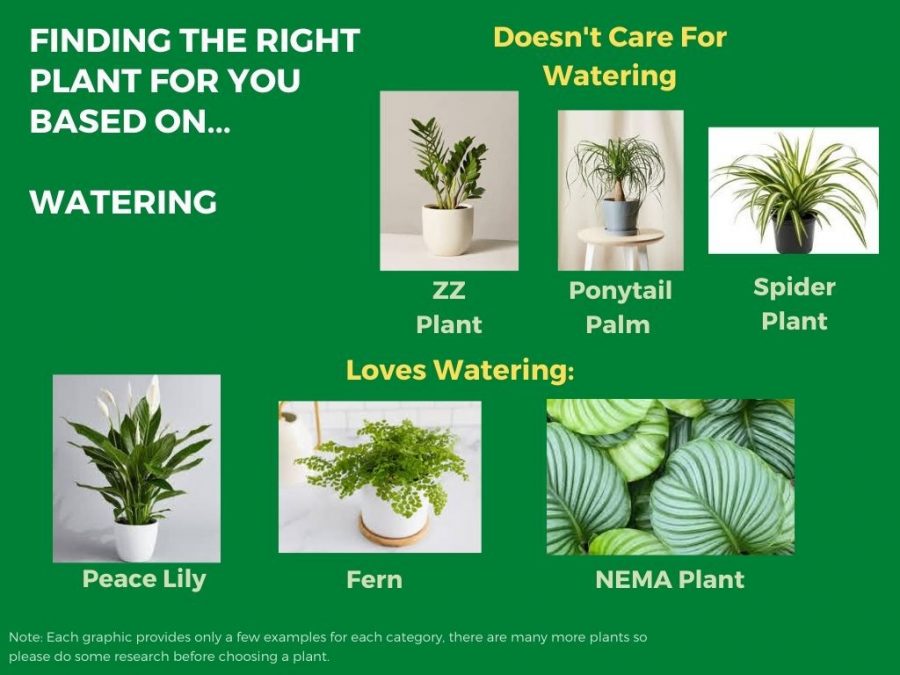Turning a new leaf with greenery
Blank, desolate walls. Dusty shelves. Lifeless spaces. Boring rooms. All of this is what quarantine has left many isolated in, yet there is one leafy item that can help change this — plants!
In quarantine, many have turned to hobbies such as binge watching TV shows, playing Among Us or exercising. According to Gretchen Mason, a greenhouse Plant Specialist at Merrifield Garden Center, many have also turned to plants.
“Watching Netflix is fun for the first couple months, but [my coworkers and I have] found a lot of people are buying plants just for something to do,” Mason said. “People are getting more into collecting plants and it’s becoming more than just a passive thing. It’s really getting to be more of, I would say, a hobby, and an active hobby.”
The garden center’s customers are not alone in this, as plants have also become popular among Washington-Liberty (W-L) students. Sophomore Cady Shenk, owner of two plants, has become passionate about them as well.
“Being around plants makes me want to know more about them, and they make me calm,” Shenk said. “They give me something to take care of which definitely has helped to keep me sane in quarantine.”
Not only do plants help give owners something to do, they also brighten up a space, according to junior Sophia Bailey.
“Plants make such a large difference in the atmosphere of a room,” Bailey, owner of more than ten plants, said. “They make rooms seem lighter, more peaceful, and happier. Plus, where there’s plants, there’s usually sunlight. So the room overall just seems somewhere you want to be.”
Plants also can be meaningful for reasons as simple as just watching them flourish.
“I think the best thing about owning plants is seeing them grow,” Bailey said. “Watching a plant grow from… a tiny plant, to a big and blossoming one is a really interesting thing to see.”
Some may not expect their plant to reach the level of “big and blossoming,” but instead last for a year or less, however with the proper care they could actually last for decades. Nicole Arthur, a W-L parent and plant lover, has had her Oxalis, a flowering clover plant, for more than 45 years.
“I got the plant from my mom… it’s probably been alive since the late seventies,” Arthur said. “It’s amazing that it’s been alive so long, it’s like the matriarch of my plant family is really, really old and still thriving.”
However, Arthur acknowledges that plants may not be for everyone.
“Even though it’s [taking care of plants] a lighter burden… it’s still on your to do list, you know, whenever you need to water them,” Arthur said. “There are also some people that truly have whatever the opposite of a green thumb is.”
Plants may not be catered for some lifestyles, but Bailey, a plant enthusiast, argues that everyone should give plant ownership a shot.
“Just try it out!” Bailey said. “You never know if you’ll love having plants until you do.”
If you know a friend or family member that you think may be in need of some plants in their life, you would not be alone, Bailey added.
“I love to give small plants to people,” Bailey said. “You’d be surprised by how much joy a small plant can bring someone.”
A fellow plant lover, Shenk agreed as well due to plants’ longevity, as did Arthur, who advocates for them as being an excellent present.
“People give plants as a more generic gift, but it’s actually fairly personal because it requires that you actually dedicate yourself to doing something,” Arthur said.
Plant Care Guide:
After listening to the arguments of numerous students and a parent, you may now want a plant, but be unsure as to how you could keep it alive.
Thankfully, Mason is here to help. An owner of more than 200 plants, it wouldn’t be much of an exaggeration to say she is experienced and knows a thing or two about them.
Tips For New Plant Owners:
If you’re inexperienced heading into your new journey of plant ownership, do not worry, as there is the right plant for you. However, that doesn’t mean you should start out with a plant you know little about.
“Do a little research before you buy a plant,” Mason said. “Lots of people are getting caught up with ‘I want this trendy plant.’ They may not even know what conditions the plant needs. Don’t get in over your head. You wouldn’t go to college and right away start taking a 300-level class because you love the subject, when you’ve never even taken the beginning class. Start with an easier plant and then work up to the more intermediate plants.”
Even if you follow all of the advice given, it is possible to somehow end up killing a plant. According to Mason, the key is to keep trying.
“It’s sad when you kill a plant,” Mason said. “It happens to all of us. If anyone tells you they’ve never killed a plant, or that they don’t care, that’s not true. We all kill plants.”
Pricey Plants:
An obstacle that many people face is getting high quality plants for a low price. This includes Shenk, a student and a plant lover.
“The only thing I do not like about plants is that they are always so expensive.” said Shenk. “Personally, I don’t think you should have to pay so much to have some greenery in your room!”
Mason, however, has a solution to the problem many on a budget face.
“We have [at Merrifield] all these [plant] miniatures, they range anywhere from $4.99 up to $9.99, in a two by two and a half inch pot,” Mason said. “So for instance, if I bought a miniature, I could try that out without making a big financial investment. And then more important for me, it could be done without taking up a lot of space.”
These miniatures include a variety of plants, which may come as a surprise to some.
“In the little miniatures, we have String of Pearls, String of Dolphins, Lipstick Plants, you know, all those in almost every kind,” said Mason. “The other nice thing about them is they’re teeny, so you don’t need to replant them right away. Any of the miniatures are easy to keep small, as you can just cut them back [unless you want them to grow larger].”
Watering Worries:
At her job, Mason does a fair share of customer service, including answering any questions or concerns customers may have about their plant, the main one usually being watering.
According to Mason, most customers base their watering on a schedule, and on a certain day they’ll water that specific plant. However, this is not the best method to ensure the health of your plant; touching the soil is.
“Depending on the type of plant it is, if the top of the soil is not dry, you’re [usually] not gonna want to water it.” Mason said. “Your finger will tell you when to water, [not the number of days]. I’ll have people coming in and buying five plants from me and they’ll say ‘how often am I going to need to water this plant?’ and I’ll say ‘you want to let it dry down about a third between watering.’ Then they go right back and go ‘okay, so is that about once a week?’ That’s the biggest hurdle that people just have to learn.”
Other than not checking the soil before watering, the biggest mistake people often make is simply not paying attention to their plant.
“People come in and say ‘I always give my plant two cups of water every Friday. It’s always been great. But all of a sudden, boom, today I wake up and it looks bad,’” Mason said. “That’s because the roots have been declining but you haven’t seen that. Once the root rot starts settling in, there are things that you will typically see, like leaves starting to turn yellow… and they’re more soft and kind of sloppy, droopy [as well]. If you see mold on the soil, that can also be an indication that you’re watering too frequently.”
Mold may seem like an issue to be worried about, but in reality it is usually harmless and should just be treated as a sign of overwatering.
“Cinnamon on top of the plant [will get rid of it]; it’s a natural anti-fungal,” Mason said. “There are all these cool little tricks that you can learn instead of going out and buying expensive products.”
As for the more serious issues, such as waterlogged soil and a dying plant, more action will need to be taken. This includes letting the soil dry out before it is watered again and placing paper towels underneath the pot. It may even be necessary to remove the plant from its pot and let the plant rest on paper towels. Along with those methods, lighting and repotting also play a key role in the recovery of a plant.
“Put [the plant] in a slightly brighter spot, but do not put it in an oven.” Mason said. “As a last case resort, if it’s just super wet and … you know it’s not going to dry out in time, you would need to take the plant out of the pot, remove the wet soil, and then repot the plant in some drier soil.”
How over-watering affects the plant, however, is an issue that many may also know little about, but mainly comes down to there being a lack of oxygen in the soil.
“Most plants like to experience their roots drying out anywhere from a little bit to a lot between watering,” Mason said. “If the soil is too moist, the roots are not allowed to dry out. All that extra water in the soil is going to push out the oxygen there, when there needs to be some oxygen down in the soil. When people water all the time, the soil is getting more and more packed down. With the compaction there’s not as much oxygen, and so without it the roots are staying too wet and actually will start rotting.”
Unlike overwatering, the effects of under watering are fairly basic, as plants simply become deprived of necessary nutrients to survive, flourish and grow. Under watered plants do however give telltale signs as to when they are in need of water, similar to overwatered plants when they need to be dried out.
“[A key sign of a dried out plant] is that first bit of wilt…, some plants will be super dramatic [about it].” Mason said. “You can also start seeing it especially when leaves get a brown spot with a yellow halo around them. That shows that at some point, that plant went too dry, and is a classic sign. Black or brown leaves, however, mean they’ve been given too much water.”
Solutions for a dried out plant, other than simply watering, will be necessary when a plant is dying in drought.
“Take the plant to the sink and water really thoroughly,” said Mason. “Then gently go ahead and put it… on a towel or paper towel on the floor, however big the plant is and lay it on its side. That’s going to mean the plant is not going to have to pump the water up to the tips of the leaves and fight gravity, it’s going to be horizontal. I call it horizontal and hydrate. It saves the plant.”
According to Mason, it is also important to note the change in watering required in the summer and winter.
“Typically, most people’s houses are a little bit cooler during the winter, and usually darker because they’re getting fewer hours of daylight,” said Mason. “If you’re getting fewer hours of daylight, the sun is weaker. Generally people are watering a little bit more during the summer, and will water a bit less than they do during the winter.”
Overall, paying attention to your plants is what will help the most in keeping them alive.
“Your eyes are your best tool because you want to notice little changes before they turn into big issues,” Mason said.
However, if that still does not work, there are other options to preserve your plant.
“If you want to take cuttings of your healthy plants and root them, it’s kind of like insurance. You know if something goes bad down the road, you still have your cutting.”
Potting:
Potting is likely the easiest aspect of owning plants, yet is one that many, unbeknownst to them, do incorrectly due to the many myths about it. One myth is that the bigger the pot, the healthier the plant.
“If you buy a plant that comes in a four inch pot, you should get a four inch pot for it,” Mason said. “You shouldn’t be like, ‘oh, well it will grow this big eventually.’ [My coworkers and I] normally say that you never want to repot something into a pot that’s any bigger than two more inches in diameter. [For instance], a [plant potted in a] four inch pot could go to a six inch [pot].”
Repotting into another pot after purchasing a plant also might not be as necessary as people think, as plants that are sold often travel from nurseries to trucks and planes and then to garden centers.
“The best thing is to keep a plant in the nursery or plastic pot for a while,” Mason said. “[If you re-pot it] you’re uprooting it and putting it in another pot, so it’s just too many changes at once. You can always get a decorative pot and put the plant [and the plastic pot] in it.”
As for what goes in the bottom of the pot, there are a few guidelines to follow, one of the most necessary being the use of a drainage hole. According to Mason, almost no plants will do well without one, therefore making it essential to the health of a plant. However, the drainage hole should also be covered.
“You want to put a little piece of landscape fabric or a coffee filter over the drainage hole, something that’s going to keep the soil from washing out, but no rocks.” Mason said. “An inch or two of gravel at the bottom [of the pot] will … cause the plant to have less room because the rocks will take up valuable root space… [along with] making the roots start growing around them… and the roots will [also be] unable to dry out.”
Air Cleaning:
Many purchase plants in the hopes of cleaning the air around them. However, according to Mason, this is mostly just another myth unless one buys a specific number of plants.
“People don’t realize that having one plant in your room is not going to make any difference,” Mason said. “The fine print is you have to have ten plants per 1,000 square feet [to make a difference]. So if you have a 5,000 square foot house, you should have 50 plants. If you have a 3,000 square foot house, you should have 30 plants.”
To Mason, however, the benefits of having a plant are not just clean air.
“People will come in and say they want some of the top air cleaning plants because they want their air to be clean, and we give them a list of the suggested amount that they need [and what kinds are best],” Mason said. “But it’s just going to make you feel so much better, having those fresh plants in your house.”













